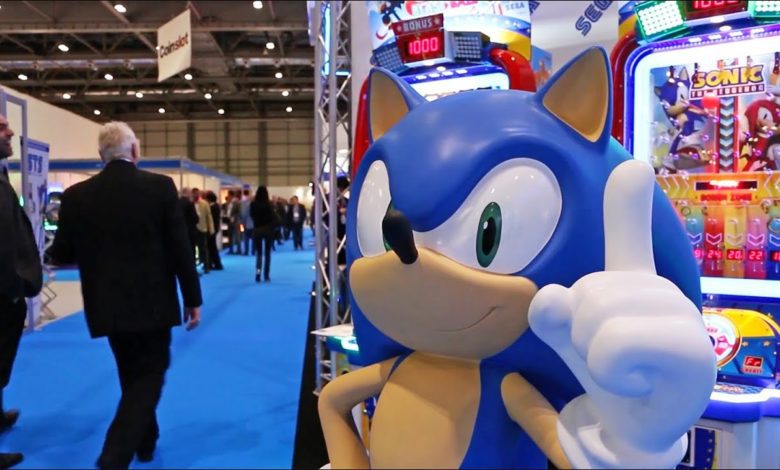
SEGA Nerds in Monster Land

It is no secret that we at SEGA Nerds absolutely adore the Wonder Boy series. From the original game all the way down the timeline to Monster World IV, we have played and loved them all. Not a day goes by we don’t long for a new entry in the series. How cool would a brand new Wonder Boy in Monster World title be on the Nintendo 3DS or the Playstation Vita?! We can but dream.
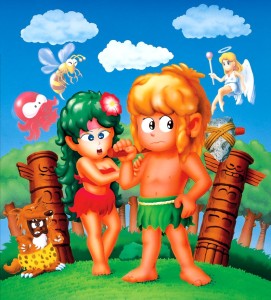
Each entry in the franchise was developed by Japanese company Westone Bit Entertainment. The studio is based in Sumida-ku, Tokyo and was founded under the name Escape in May, 1986. Company founders Ryuuichi Nishizawa and Michishito Ishizuka soon became concerned with the company name, worrying that it would make them sound unreliable. It was because of this the company was re-branded as Westone, combining the surnames of both founding peoples (Nishi meaning West along with Ishi meaning Stone.) The name stuck and it wasn’t long before eager Japanese gamers were seeing it plastered all over their television screens.
Westone began developing SEGA arcade titles, such as Riot City, Aurail and of course, Wonder Boy. They later developed games such as Dungeon Explorer for the Mega CD, Willy Wombat for the SEGA Saturn and Shinseiki Evangelion: Ayanami Ikusei Kaikaku for the Dreamcast. Westone was not strictly tied to SEGA as they also developed for other popular systems. A couple of these were Nintendo’s NES, on which Westone released a two-dimensional action title loosely based on the Jaws franchise and also the PC Engine, which was home to a mecha based RPG named Blood Gear.
Let’s be honest. Their portfolio isn’t perhaps the most impressive for a Japanese game developer of the time. Do not let that put you off, though. Their heart and souls were poured into each Wonder Boy title and it certainly shows!

There are two distinct play styles in the Wonder Boy series. Firstly, we have the good old Wonder Boy titles. These games feature high speed platforming action, with simplistic but addicitive gameplay. Players run from the left side of the screen to the right, dodging traps, fighting enemies and collecting fruit to prevent a tricky timer from fully depleting.
Secondly, we have the Monster World series. These fall under the same franchise as Wonder Boy and often include the name in the title, however they are different. The Monster World games are much slower paced and feature adventure RPG style gameplay. Combat and puzzle solving are the main gameplay mechanics, with an open world environment to explore and many non-playable characters to interact with. Players are able to collect items too, either by becoming victorious in an end of area boss fight or by purchasing them from a store.
Due to these two different play styles, both Wonder Boy and Monster World eventually became entirely separate entities. However, it took time for this change to occur and Westone certainty didn’t help in defining which game belonged to what series. Take for example Monster World III: Dragon’s Trap for the Master System that is then followed by the absurdly named Wonder Boy V: Monster World III for the Mega Drive. Confused yet? We wouldn’t be surprised, but don’t worry if you are losing track.
Over the course of this retrospective we will be discussing the six mainline Wonder Boy / Monster World titles along with the arcade and SEGA versions of each. For the purpose of not turning things into a complicated mess, all six will be discussed in this order and will be referred to by the following titles: Wonder Boy, Monster Land, Monster Lair, Dragon’s Trap, Monster World III and finally, Monster World IV.
With all of that said it is time to move on to our first title in the series, known simply as…
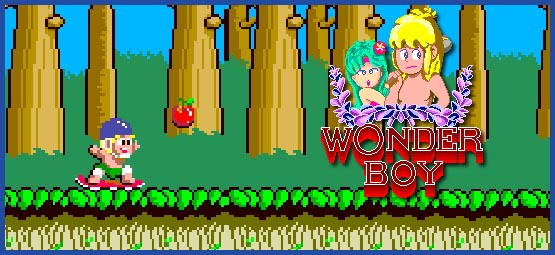

Wonder Boy was released in arcades during 1986 and it features challenging but addictive platforming action.
The story is simple. You play as Tom-Tom. No, not the satellite navigation system. Instead, an adorable little caveman with a passion for skateboarding. Tom-Tom, despite looking as happy as larry, is actually in quite a bit of distress. His cute little cave girlfriend Tina has been kidnapped by the generically named Dark King (seriously?) It’s a race against the clock to save Tina, as Tom-Tom must make his way through seven dangerous worlds.
The first Wonder Boy game may appear as a simple left to right platformer, but it does have a twist. As we mentioned, Tom-Tom is in a race against the clock and we mean that quite literally. What may appear at first as a life meter at the top of the screen is in fact a timer. The timer depletes at a relentless pace and the only way to fill it back up again is to quickly run through the stage and collect the fruit scattered about the place. It may sound ridiculous at first, but it makes sense if you think about it. Eating plenty of fruit improves ones life expectancy and let us just say poor old Tom-Tom here doesn’t look like he will be lasting the night unless he speedily gobbles down at least fifty portions of apples, bananas and oranges.
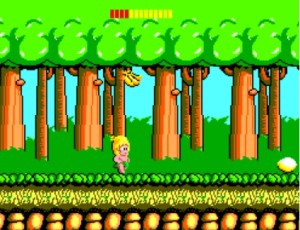
Perhaps the development staff didn’t put that much thought into the storyline. It is an arcade game, after all! The depleting timer in addition to the enemies and tricky platforming segments found throughout each stage make it incredibly easy to die, which is not a bad thing for the man collecting the quarters from the coin box. It is however never frustrating enough to the point of quitting, as four generous checkpoints are placed around each stage. They help in softening the blow if Tom-Tom ends up leaping into an enemy or taking a deadly decent down a bottomless pit.
Speaking of enemies, there are plenty of them here. From giant snails to poisonous spiders, everything is out to get our buddy. Thankfully, players are able to collect stone hatchets found inside giant bird eggs and use them as a means of conquering foes. Take that, nature! There are a few other useful collectables found in every stage too. One is a small doll in the shape of your girlfriend, Tina. These award you bonus points at the end of a stage. Who left those things around the place anyway…? There is also a small fairy that sometimes appears and grants Tom-Tom invincibility for a limited time. This is without a doubt the most useful power-up in the game.
We just cannot mention Wonder Boy without talking about the skateboard! If players already poses the stone hatchet weapon and bust open another of those giant bird eggs, it is very likely the skateboard power up will appear. Tom-Tom now dons an adorable little helmet with matching knee and elbow pads (safety first!) The skateboard will allow players to move faster and jump higher. It is a bit of a double edged sword though, as despite having improved agility it’s now a lot trickier to control. Master the skateboard and you will soon be whizzing across the island like nobodies business.
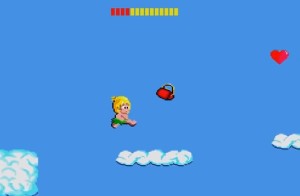
Another one of our favourite collectables in the Master System version are the four hidden letters. Collect all of them and you spell out the word SEGA. What’s better than spelling out the name of our favourite company? Maybe the fact that the classic SEGA Master System jingle plays each time you collect one of them? It’s a small detail, but still incredibly nostalgic and it’s a great little exclusive for the home console port.
We just have to commend Escape for the colourful graphics seen here. Both the arcade and SEGA Master System versions look fantastic. While the sprites are not perhaps the most detailed for a game of the time, the choice of colours is great and everything has such a warm, tropical feeling to it. From the bright green leaves on the trees to the deep blue oceans, Wonder Boy certainly is an impressive feast for the eyes, especially when you consider the older hardware powering it.
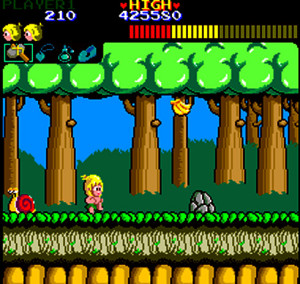
Another aspect to note is that this game is long. Arcade platformers typically only take around twenty to thirty minutes to complete, but Wonder Boy? It will take even the most experienced players over an hour to reach the final boss. It is no walk in the park either… actually, it’s probably better described as a sprint along an obstacle course from hell.
The control for Tom-Tom on-foot feels sluggish, making it extremely difficult to traverse over some of the harder platforming segments. Much like Super Mario Bros. on the NES, it’s also impossible to retrace your steps. If you miss a vital piece of fruit and allow it to disappear off screen to the left, it’s gone for good.
If you can deal with the one hit KO’s and the challenging gameplay, it soon becomes addictive and a tonne of fun. Despite this, the game didn’t exactly send Westone off to a flying start. Wonder Boy came under fire from some mediocre review scores, with Crash awarding it a measly 43%. Still, what do reviewers know… right?
Later in 1986, Escape had the desire to port the arcade title onto several other home consoles. This was however, not to be. Much to the development teams dismay, SEGA owned the rights to main character designs, the bosses and the games title. Dissatisfied with the situation, Escape conjured up a plan. They teamed up with Hudson Soft, a Japanese development studio best known for their Bloody Roar, Bonk and Bomberman franchises. Keeping all of the gameplay intact, Hudson Soft created a new title altering only the playable characters, bosses and the title of Wonder Boy.
It was then Adventure Island was born. This clone game released on the NES, MSX and the Game Boy that very same year, 1986. It even had Hudson’s name plastered all over the front of the game box. Ouch… poor SEGA!
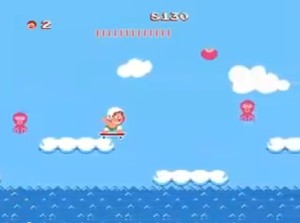
Adventure Island quickly picked up fans just as Wonder Boy once did back in the arcade. In fact, the NES version became so popular it lead to a fruitful relationship between Hudson and Nintendo. Escape quickly sold the IP to Hudson and they… well, escaped while ahead of the game. The franchise continued on for many more years with the most recent release hitting Wii Ware during 2009. It is quite ironic that despite coming second, the Adventure Island series has had a longer shelf life and spanned many more titles than Wonder Boy ever did.
![]()
So, what was next for our friends over at Escape? The company decided to change their name to Westone and take the Wonder Boy series in an entirely new direction, one that many would consider was for the best!
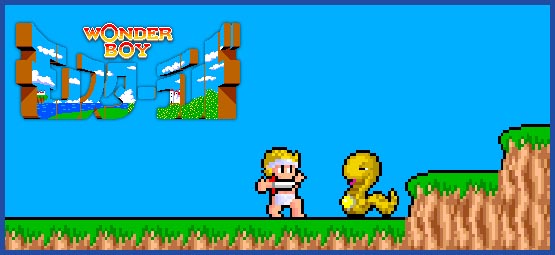
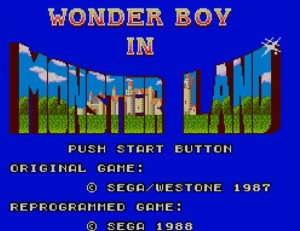
Wonder Boy in Monster Land is a side-scrolling adventure RPG that launched in the arcade during 1987 and on the Master System in 1988.
Developers Ryuchi Nishizawa and Michishisto Ishizuka decided to take a look at industry trends before jumping into the development of a second Wonder Boy title. With popular adventure RPG titles such as Dragon Quest, The Black Onyx and Wizardry all emerging from Japan, it was clear which direction needed to be taken.
The duo decided to scrap the tropical island setting of the first Wonder Boy game and leave it to Hudson’s Adventure Island. Instead, the sequel featured a swords and shields style medieval setting. One thing they did keep during the transition however was the large variety of monsters. This was to be such an important aspect to the games storyline and battle system that they just had to add it into the title, Wonder Boy in Monster Land.
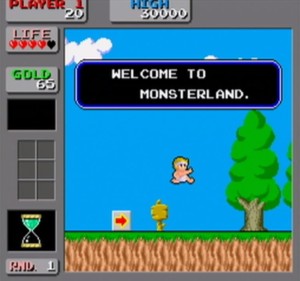
The second game in the series differs from the first one in almost every way. It acted as a complete relaunch of the franchise and oh boy, was it a good one. Our hero from the first title, Tom-Tom, returns once again. After saving his girlfriend Tina from the evil Dark King’s clutches, he was hailed as a hero and the mighty title of Wonder Boy was bestowed upon him. Eleven short years of frolicking through the fields later, an evil fire breathing dragon appeared out of no-where. Known across the lands as MEKA Dragon, this enormous metal beast began terrorising the lands inhabitants, who after living calm and casual lives for the past eleven years were a bit rubbish in combat. In fact, they all died.
Much as Nintendo’s famous Legend of Zelda franchise repeatedly does, the fate of the world is left in the hands of a small boy. The mayor tracks down the now teenage Tom-Tom, hands him a life potion and leaves him to set off on a quest to defeat the dragon. Seriously, what is wrong with the municipal governments of computer games? Leaving his girlfriend Tina and all that he loved behind him, Tom-Tom marches forwards, once again racing against a constantly depleting timer as he crosses the land to infiltrate the dragons nightmare castle. God speed, old friend.
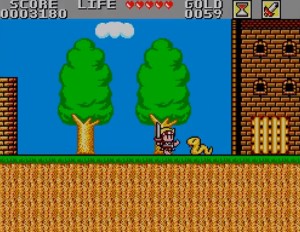
As mentioned before, the gameplay of Monster Land is very different to Wonder Boy. Players begin wearing nothing but their pants and they are not even in possession of any offensive weaponry. Could our supposed hero be any more ill prepared? The heads up display for the second title is far more important than it was prior. In the arcade version, the players life energy, gold and possessed items are all displayed in large grey boxes placed around the top and left edges of the game screen.
Just like with the first title, everything is out to kill you. The arcade version is a quarter muncher and you will find yourself piling more in the coin slot sooner than you would expect. Players begin with four hearts. Life energy can be lost either by coming into contact with a monster, a hazard or if the small hourglass timer at the top of the screen runs out and resets itself. There are some tricky platforming segments integrated into the level design and plenty of bottomless pits to fall right in to, so be sure to watch your step.
Gold can be collected either by defeating enemies, finding it in treasure chests or by simply rummaging through parts of the scenery. A neat feature in the arcade original grants you with more gold if you frantically wiggle the arcade joy stick while picking up coins. While it is always great to receive more moola, mashing the control stick left and right soon becomes tiresome. Gold is extremely important though, as you will need it to purchase new gear from shop keepers. Tom-Tom really is ill equipped as by area two players should be thinking about buying armour, shoes, a helmet and a shield. None of it comes cheap so you will likely be grinding monsters against the clock if you wish to afford the good stuff.
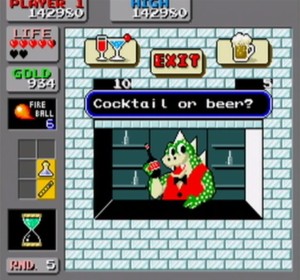
Let’s talk about how the game plays out. Each stage is referred to as a round and there are eleven in total. Players successfully complete a round by reaching a castle gate situated at the end of the path. It’s much easier said than done, as every path is littered with monsters, traps and moving platforms. Players can jump, swing their sword or use magic. The magic attacks are obtained throughout Tom-Toms journey and they range from weak attacks such as the fireball to more powerful ones such as a devastating tornado, or Wind Sprout as it is referred in-game. Sounds more like a Pokémon than a deadly magic attack, to me.
The Wonder Boy series developers sure do enjoy adding items into their games, as we can guarantee there will always be a tonne of useful ones hidden throughout the stages. Monster Land includes attack pick-ups, such as bombs. These can be obtained and placed by the player, but remember to run away quick or risk getting caught in the explosion. There are life potions, a golden gauntlet that increases attack power and even a magic flute that helps you locate a hidden mansion area in round seven. Perhaps the most useful of all is the golden helmet. Find one of these and the damage Tom-Tom takes is reduced by 50%. Extremely useful when fighting boss characters.
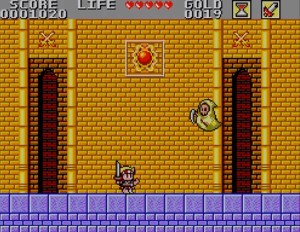
There are secret doors leading to hidden boss fights that can be tackled by the more adept Monster Land player. These mini-boss battles are often optional and upon beating the super monster inside, the reward will either be gold, life energy or a key. Considering the value of each of these items, it’s definitely worth it! Most of them are not easy. It is possible to be totally unprepared for some of these fights, lacking the equipment needed to prevail. If this does happen, you will regret knocking on that boss door. Sadly, there is no way out. Instead, your only option is to make the fetal position in front of the arcade cabinet and cry manly tears for poor Tom-Tom.
This title really is a challenge though and it is by no means perfect. At times we feel the hourglass to be a little too harsh, as it can run down at the most inopportune moments. Imagine being in the heat of battle. You have given your all and you are about to beat the boss. One last hit, he’s down! But wait, the timer… it’s about to run out! Game over, much crying to be had, etcetera. We also really do not enjoy the constant high pitched beeping sound when low on health. It is always good to have a warning, but make it subtle. I often find myself going out of my way to grind enemies for hearts just to stop the incessant high pitched noise.
Monster Land is a great addition to the series as it truly offered some new and unique gameplay. RPG titles typically aren’t the best for arcade gaming, but in this case it works well. Things soon escalate after beating the second or third round, with the players upgrades allowing them to dash through the stages, bash the baddies and beat the clock. It’s very fun and it soon begins feeling a little like the first title, relying on player skill and precision to make it to the end of the round.
![]()
Life is so much better in Monster Land however, as the RPG elements add a whole new layer of depth and they help keep the gameplay feel more interesting. Tom-Tom transforms from a small boy wandering around in his underpants to a fearless warrior, donning heavenly armour and kicking unprecedented amounts of arse. We love it!

Both titles featured in this article drummed up enough activity in the arcade to warrant home consoles ports on various systems. For the time being, let’s take a quick look at both the arcade and SEGA Master System versions of each as well as sharing short opinions on all four…
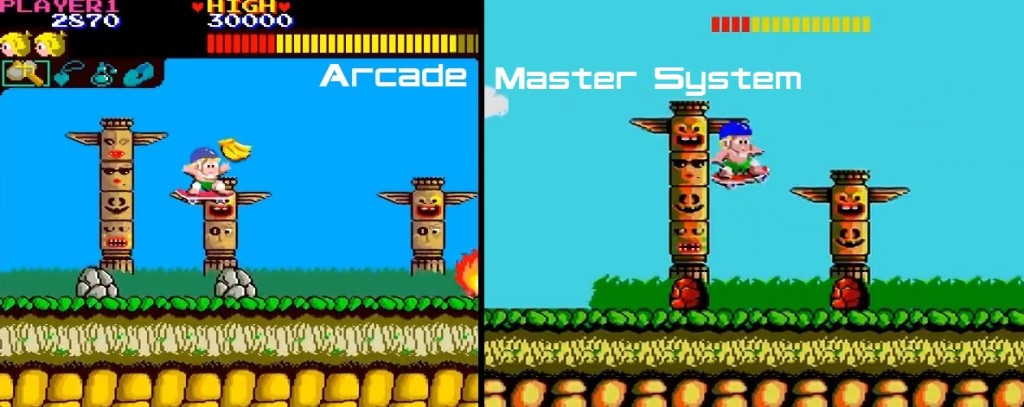
The home console port of Wonder Boy is excellent. Everything from the arcade original is captured perfectly, from the high speed gameplay to the simplistic yet vibrant visuals.
Despite lacking the sprite detail of the arcade, the 8-bit home console port of Wonder Boy is a tonne of fun and the systems directional pad is much more suitable for some of the tougher platforming puzzles. The arcade original gets plus points for nicer visuals and a superior heads up display, but when it comes down to gameplay versus graphics, we know which side we’re taking. If we were to pick one of the two, it would have to be the Master System version all the way!
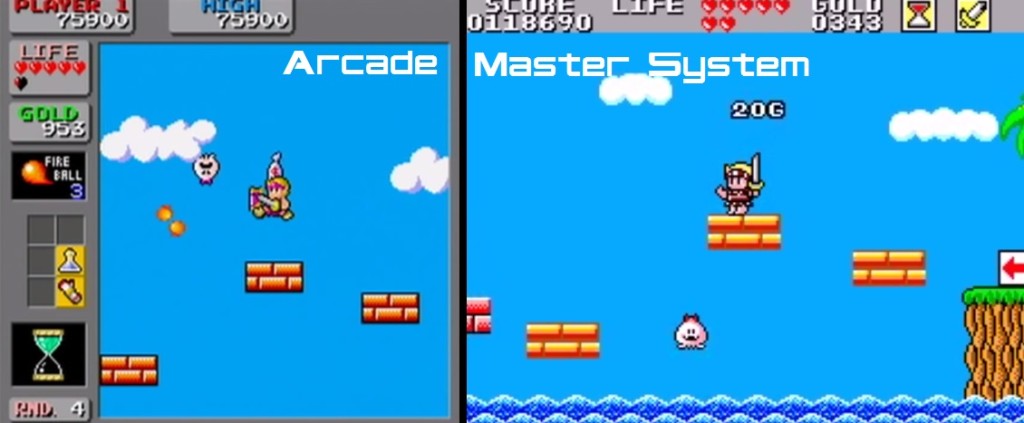
Monster Land is a lot of fun in the arcade and at home. In fact, if it wasn’t for the harsh timer, the home console version would not feel like it originated from an arcade title at all! The controls are tight, all of the stages are intact and the music sounds excellent for a game of its time, coming from either the Master System hardware or via the FM sound unit.
With that said, we cannot help but prefer the arcade version. Mashing the arcade cabinets control stick left and right when picking up currency is much more effective than using the SEGA systems spongy directional pad. While it does better serve for more precise control, the richer you are the stronger you become in Monster Land. We also can’t help but feel miffed that the time limit was kept in the home console port. The game itself is challenging enough without it, did it really need to survive the transition?
How do the home console SEGA ports fare against the opposition? What became of Adventure Island and just who truly is the better protagonist, Tom-Tom or Master Higgins? These are but a couple of questions we will address in a later edition of SEGA Versus, so stay tuned!
Westone were certainly onto a winner with the Wonder Boy series. While the franchise promptly headed in new directions after only one title, we just cannot forget the original. It is often left buried amongst the many sequels to Monster Land and the popularity of Adventure Island on Nintendo’s NES eventually overshadowed it. Not only was the game excellent, but Nintendo’s home system was far more popular in Japan and the US during the late eighties. Hudson’s victory was inevitable.
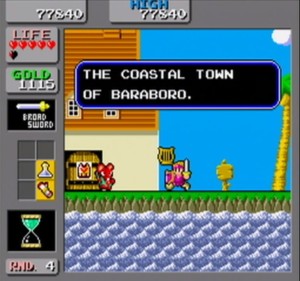
The unique two-dimensional action adventure play style of Monster Land was a sure fire hit in the arcade and was a fantastic start to the Wonder Boy in Monster World spin-off series. The title set the foundation for many other games, including two exclusive to the 16-bit SEGA Genesis. Like all good development companies, Westone built upon the core gameplay each time a new iteration was released, making each new adventure in Monster World bigger and better than ever. Monster World remains one of my favourite two dimensional adventure titles of all time and it all started with this. I just have to give it credit!
These are two great games of SEGA’s past. Be sure to check them both out!


Next time we head into the monsters lair and explore two further Westone developed Wonder Boy titles.
Monster Lair released in arcades during 1988 and was ported to many home consoles, including the Mega Drive. It’s not your standard Wonder Boy affair, as the play style has been mixed up a whole bunch since Monster Land. We’re not going to say how just yet, so you will have to stay tuned to find out! Our second game is a Master System exclusive and is often considered one of the best. The Dragon’s Trap returned to its Monster Land roots, with some refined gameplay that puts many other adventure RPG titles to shame.


